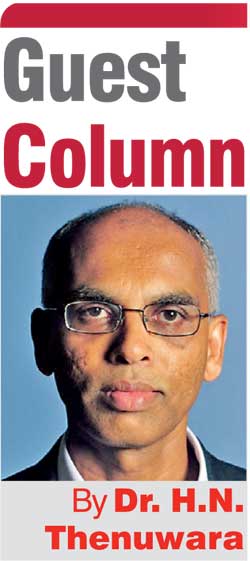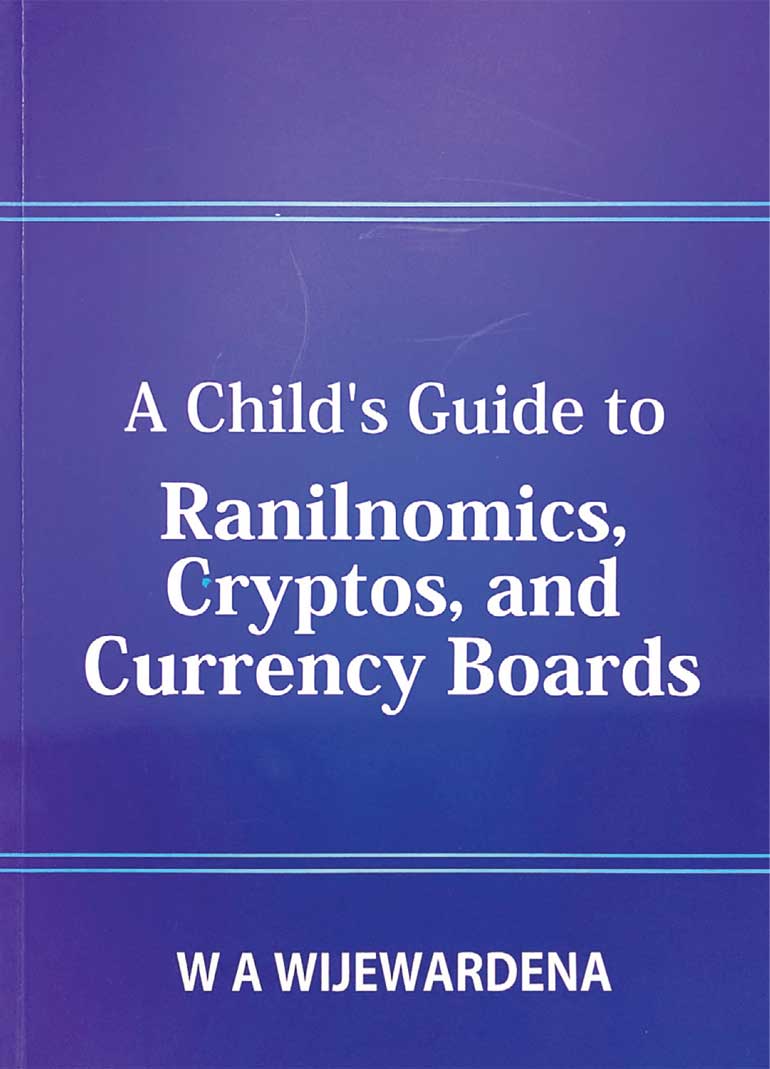Wednesday Dec 17, 2025
Wednesday Dec 17, 2025
Monday, 30 January 2023 00:09 - - {{hitsCtrl.values.hits}}
 Dr. W.A. Wijewardena (author), a former Deputy Governor of the Central Bank and presently an independent economic analyst, has penned a timely and comprehensive book highlighting current economic problems of Sri Lanka, challenges faced by the President in managing complex economic problems, and two alternatives to the existing system of national currency and monetary arrangement under the themes of Cryptos and Currency Boards. The book leaves the reader with a full and comprehensive understanding of all evils befallen on the country.
Dr. W.A. Wijewardena (author), a former Deputy Governor of the Central Bank and presently an independent economic analyst, has penned a timely and comprehensive book highlighting current economic problems of Sri Lanka, challenges faced by the President in managing complex economic problems, and two alternatives to the existing system of national currency and monetary arrangement under the themes of Cryptos and Currency Boards. The book leaves the reader with a full and comprehensive understanding of all evils befallen on the country.
The book comprises of 18 parts or chapters divided into three sections. The sections are ‘Ranilnomics’, ‘Cryptos’ and ‘Currency Board Systems’. The author has compiled these chapters as dialogues between a young girl (Aseni) and an old gentleman (Sarath Mahatthaya) to educate an eavesdropping third person, the reader. The two names have been picked up, according to the author, from two popular characters in a teledrama that is being telecast over television in Sri Lanka, perhaps to make the dialogue more entertaining to the readers. It is a narration of the reality written with the readability of a fiction. The young girl represents all the young adults who have an entire lifetime ahead of them. The old person or grandpa represents a retired public servant who has a wealth of experience.
The grandpa might be knowing those in the policy making circles of the Government. It is also likely that many of the colleagues of this grandpa come back to hold Government positions after their retirement. Some of those policymakers do a good job, while others are rent-seekers and must be grateful to the political masters who have given them the opportunity. As a result, they are inclined to bend policies to benefit those political masters as well as themselves or simply because of sheer ignorance of economic theory.
 As the conversations proceed, the reader may get both angry and sad. The reader may get angry at current and past policymakers who have made policy blunders or continuing to make policy blunders. The reader may get sad because the young girl keeps asking questions though she realises that these rent-seeking individuals are robbing her of her future and of others in her generation.
As the conversations proceed, the reader may get both angry and sad. The reader may get angry at current and past policymakers who have made policy blunders or continuing to make policy blunders. The reader may get sad because the young girl keeps asking questions though she realises that these rent-seeking individuals are robbing her of her future and of others in her generation.
The first section is devoted to current economic problems, and challenges faced by the President of Sri Lanka, Ranil Wickremesinghe (RW) and strategies, dubbed for easy reference and distinguishing from other policies as Ranilnomics. RW has inherited a bankrupt economy. His economic policies and efforts to curb corruption are the only hope people will have for the recovery of Sri Lanka until the next election.
In the first chapter of the book, the author has identified RW’s declared economic strategy as ‘social market economy policy’. This is the middle path between laissez faire (leave it to us in French or Neo-Liberalism) and socialism where the Government has a substantial control of the economy. Almost all countries in the world are at some point in between these two extremes. Sri Lanka being a vibrant democracy with significantly rigid State-Owned Enterprises, RW cannot implement neo-liberal policies. It is also hard for him to pursue prudent economic policies because the parliamentarians who support him to remain in power are oblivious to the crisis and keep enjoying good lives (licking honey in the author’s example of a person facing five forms of death threats, though in this case population faces death threats while others sit in comfortable chairs licking honey). In contrast to any Neo-Liberal policies, there are massive government interferences such as import controls, heavy taxes, and high interest rates.
At the end of the chapter, the author summarises ‘Ranilnomics’ as excessive government intervention in the economy by way of controlling imports and controlling economic activity by raising interest rates. A neo-liberal economist would argue that a realistic exchange rate would have controlled imports much better than the government. Raising interest rates is an act of misreading the economy. For any recovery, interest rates must be brought down to encourage investment, when the economy is already in a recession. I would applaud the author for writing this chapter that makes a reader jump in anger for realising that wrong medicine is being pushed down the throat of the dying country.
In the next chapter, the author addresses import controls further. The Government position, according to him, is that there is high aggregate demand in the economy and import controls and high interest rates are needed to control it. However, it is hard to believe that there is such high aggregate demand in this dying or moribund economy. Many people are holding on to straws for their dear lives, rather than demanding goods for merriment. People are constantly being assaulted by high energy prices, energy shortages, power cuts, high interest rates and high taxes. Later in the chapter, the author explains correctly that import controls such as controls on electronic devises and spare parts are unfriendly to economic growth. It would delay any recovery. At the same time, it is also sad that young adults are deprived of some luxuries of life because of foolishness of old policymakers.
In Chapter 4, the author explains why both Sri Lanka’s Treasury and the Central Bank are bankrupt. Treasury has a negative balance in the Consolidated Fund, and the central bank has a negative balance in foreign reserves. They cannot pay the existing debt and cannot borrow in the future. In addition to central government debt, there is extra debt owed by other government entities. The author further explains the geo-political dimension of Sri Lanka’s default on its debt and show that debt restructuring is a complicated process. After reading the chapter the reader may feel sorry for Aseni because the grandpa’s generation has borrowed incessantly and Aseni’s generation will have to pay it with penalties. She will not be able to borrow in the future for any development purposes to make a better life for her and others in her generation.
In Chapter 5, the author emphasises the need for an IMF bailout package, and the need for introducing strategies to develop the real sector and exports to pursue the elusive goal of reaching rich country status by 2048. In Chapter 6, he explains that the Government should balance its budget over a long time horizon. If taxes are lower today, they will be higher in the future. If they are higher today, it is likely that it could be lowered in the future. When the Government runs a deficit even with high taxes, it can resort to more perilous means of financing such as foreign borrowings and borrowing from the banking system.
Chapter 7 highlights corruption in the country through extractive institutions. Chapter 3 emphasises that RW may not only state that he follows Vajji principles of good governance, a system that had prevailed in the Buddha’s time in the system of republics run by Lichchavi clan, but also adopt them both in the spirit and to the letter. A mere lip service in this regard will not help him or the country.
Chapter 8 explains the recommendations of the Institute of Policy Studies (IPS), which is an independent think-tank in Sri Lanka. The author applauds the efforts of IPS, and requests politicians to follow those recommendations.
The frustration of the general public with the monetary system and the central bank is aptly illustrated by the peoples’ cries for adopting crypto currency and a currency board system. This highlights the deterioration of once venerable Central Bank of Sri Lanka, and the distrust of the people of this institution. In the next two sections, the author explains that though crypto currency is a good medium of exchange, it could not fulfil the other two functions of money, which are unit of account and store of value. This is because high volatility of the value of crypto currency.
In the case of a currency board, the author explains why successful countries like Singapore had retained the currency board system whereas Sri Lanka converted it to a central bank. A central bank through its monetary independence without any accountability provides various avenues of corruption. Furthermore, the central bank provides great opportunities for rent-seeking.
The author validates his arguments with the following concluding remark in the last Chapter, ‘…..What this means is that there is a serious deficiency in the governance structure of the Monetary Board. The Board is expected to function as an independent body of experts to protect the financial assets of the people. But if they become a yielding hand to some invisible powers outside and drive a country to total bankruptcy, there is no redress for people. This was evident when Governor W.D Lakshman at every forum thanked the Secretary to the President for appointing him to the post. People outside made the judgment that he was acting on the instructions of that particular high official who has no authority to do so. As such, people have now lost confidence in the Monetary Board. This may be the reason for the growing demand for returning to a currency board system today’.
At the time the author published this timely article in the newspapers, the Monetary Board was pushing the Central Bank and the entire country into a dark abyss of no safe return. Thus, it is best to remove any monetary independence from the current form of monetary authority which attracts rent-seeking individuals to its monetary board.
Finally, I wish to recommend that this excellent book must be read by all those who are voting for politicians at the next election as well as those who are seeking political power in the country.
(The writer, a former Assistant Governor of the Central Bank, presently teaches Economic Theory and Policy at the University of Iowa, USA.)